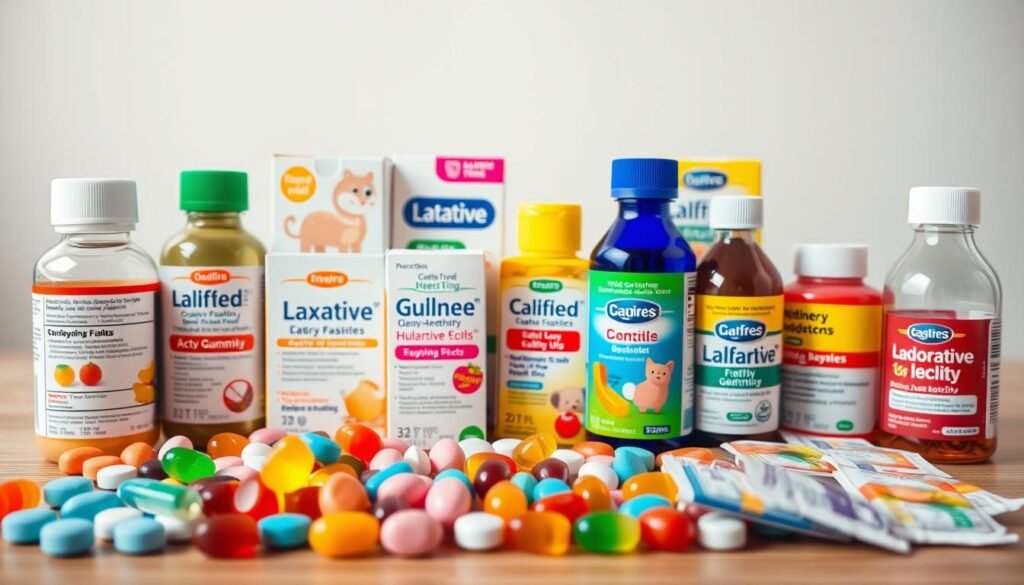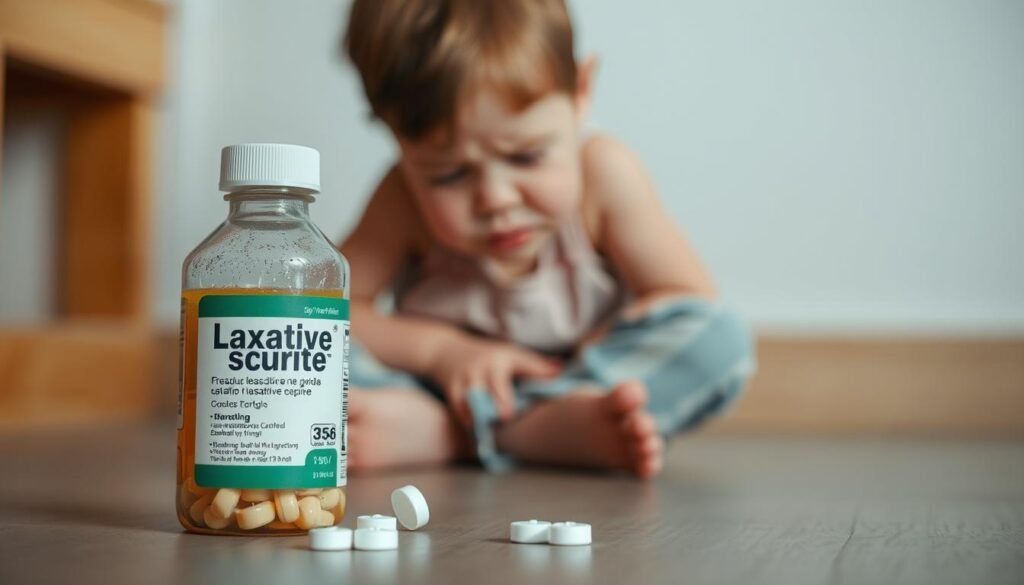Did you know that nearly 30% of kids struggle with constipation at some point? If your little one faces this issue, you’re not alone. Finding safe and effective solutions is key to keeping them comfortable.
Many parents turn to trusted over-the-counter options like Pedia-Lax® or Miralax® for gentle relief. These FDA-approved treatments work alongside dietary changes to help ease discomfort.
This guide explores safe approaches to managing constipation in young ones. We’ll cover both medical solutions and natural remedies that support digestive health.
Key Takeaways
- Constipation affects about 30% of children
- OTC options like Pedia-Lax® provide gentle relief
- FDA-approved solutions ensure safety
- Diet changes complement treatment
- Natural remedies can support digestive health
Understanding Constipation in Children
Pediatric constipation often stems from multiple factors that parents should understand. While occasional discomfort is normal, chronic issues may signal functional constipation—a common condition in infants children. Addressing the root causes early helps prevent prolonged discomfort.
What Leads to Constipation in Kids?
A child diet low in fiber or high in dairy can slow digestion. Processed snacks and insufficient water intake worsen the problem. Toddlers resisting toilet training may also withhold bowel movements, creating a cycle of discomfort.
Infants face unique challenges. Immature intestinal muscles may struggle with motility, especially during transitions to solid foods. Stressful routines, like starting daycare, can further disrupt digestion.
Healthy Bowel Movement Frequency
Normal ranges vary by age. Babies often pass stools daily, while older kids may go every 1–2 days. The Mayo Clinic notes that fewer than three bowel movements weekly may indicate constipation children face.
Active play supports regularity. Encourage outdoor time to stimulate digestion naturally. Small diet tweaks—like adding prunes or whole grains—often make a big difference.
Recognizing the Signs and Symptoms
Behavior changes can reveal hidden bowel issues before physical signs appear. Tracking both child symptoms and habits helps identify constipation early. Quick action prevents complications like painful bowel movements or stool withholding.
Physical Red Flags
Hard, pebble-like stool (Type 1-2 on the Bristol Chart) signals trouble. Abdominal pain often follows, especially around the navel. In severe cases, rectal impaction causes paradoxical diarrhea—liquid stool leaking around a blockage.
Look for blood-streaked toilet paper or underwear stains. These signs symptoms suggest small anal tears from straining. Abdominal distension—measured by gentle belly presses—may also occur.
Behavioral Clues
Toddlers avoiding the “potty posture” (toes pointed, legs stiff) often fear pain. School-age kids may hide soiled clothes due to embarrassment. Anxiety spikes before bathroom visits or meals can indicate chronic issues.
Note schedule changes. Skipping bathroom breaks during playdates or school events disrupts routines. Bedwetting in potty-trained kids sometimes links to backed-up stool pressing on the bladder.
When to Consider a Childrens Laxative
Many parents wonder when it’s time to seek help for persistent digestive issues. While diet tweaks often resolve mild cases, some situations demand targeted treatment. Knowing the difference ensures timely and safe care.
Start with Diet and Hydration
The Mayo Clinic advises 32oz of water daily alongside fiber-rich foods. For kids under 50 lbs, divide their weight (in pounds) by 2 to determine daily water ounces. Prune juice or flaxseeds can boost fiber gently.
Track bowel habits for three days. If no improvement occurs, consult a pediatrician. Chronic issues may need temporary medications to reset digestion.
Signs You Need Medical Help
Seek immediate care if your child shows:
- Vomiting or fever with abdominal pain
- Unexplained weight loss
- Blood in stool or underwear
Pediatric gastroenterologists may recommend disimpaction for severe blockages. This involves prescribed doses of osmotic laxatives like polyethylene glycol.
Types of Laxatives for Kids: A Safe Overview
Parents exploring relief options will find several safe categories of pediatric digestive aids. Each type works differently, from gentle stool softening to targeted intestinal stimulation. Choosing the right one depends on a child’s age, symptoms, and doctor’s advice.
Stool Softeners (Docusate, Glycerin Suppositories)
Stool softeners like docusate sodium (Colace®) add moisture to dry stool, easing passage. Glycerin suppositories act faster—often within 15–60 minutes—by gently stimulating the rectum. These are ideal for short-term use during dietary transitions.
Osmotic Laxatives (Polyethylene Glycol, Magnesium Hydroxide)
Osmotic laxatives, including polyethylene glycol (Miralax®), pull water into the intestines to soften stool. Pedia-Lax® Chewables use magnesium hydroxide, dosed by weight (e.g., ½ tablet for 24–47 lbs). These take 1–3 days to work but are safer for longer use.
Stimulant Laxatives (Senna, Bisacodyl) – Use with Caution
Senna or bisacodyl triggers muscle contractions to move stool. The FDA warns against bisacodyl for under-4s due to cramping risks. Overuse can lead to dependency, so reserve these for severe cases under medical supervision.
Over-the-Counter (OTC) Laxatives: Brands and Dosages
Navigating the aisle of OTC digestive aids can feel overwhelming for parents seeking safe solutions. The right choice depends on your child’s needs, from gentle stool softening to rapid relief. Below, we compare top products and their ideal use cases.
Comparing Pedia-Lax®, Miralax®, and Other Options
Pedia-Lax® Chewables use magnesium hydroxide (400mg per tablet), with dosing by weight. For kids 24–47 lbs, half a tablet suffices. Its watermelon flavor masks medicinal tastes.
Miralax® relies on polyethylene glycol, mixing invisibly into drinks. It’s flavorless but may take 1–2 days to work. Ideal for kids resistant to chewables.
Dulcolax® suppositories act within 15–30 minutes but carry FDA restrictions—avoid for under-2s due to rectal irritation risks. Best for acute relief under pediatric guidance.
Age-Appropriate Recommendations
For constipation infants children 2–11 years old, Pedia-Lax® offers precise dosing. Teens often tolerate Miralax® better due to its neutral taste. Always check labels for age limits—some formulas aren’t safe for under-4s.
Insurance coverage varies. Many plans cover polyethylene glycol solutions with a prescription, while OTC options typically require out-of-pocket payment. Ask your pediatrician about cost-saving alternatives.
Natural Remedies to Support Bowel Health
Building healthy digestion starts with smart food choices and daily habits. Simple dietary adjustments often resolve mild constipation without medication. These approaches work alongside or sometimes instead of OTC solutions.
Fiber-Rich Foods That Kids Actually Enjoy
Raspberries pack 8 grams of fiber per cup—more than most breakfast cereals. Chia pudding (3 tbsp seeds + milk) offers 10 grams per serving. The Mayo Clinic recommends starting with prune juice—just 2-4 oz daily for toddlers.
Other kid-friendly options include whole grain waffles and roasted chickpeas. Aim for “5 and 5″—five fiber-rich foods spread across five small meals. Too much at once may cause bloating.
Probiotics: Nature’s Digestive Helpers
Culturelle® Kids contains Lactobacillus GG, shown to reduce constipation episodes by 48% in studies. FlorastorKids® uses S. boulardii, which survives stomach acid better than some strains.
Probiotic therapy works best when paired with prebiotics like bananas or oats. Look for CFU counts between 1-5 billion for children. Refrigerated varieties often maintain potency longer.
Movement and Hydration Essentials
Active play stimulates intestinal muscles—aim for 60 minutes daily. Trampoline jumps and bicycle legs work especially well for younger kids.
Hydration needs vary by weight, but a simple child diet rule: offer water with every snack. Use fun marked bottles to track intake. Limit apple/pear juice to 4 oz daily—too much can backfire.
Administering Laxatives Safely
Proper dosage techniques make all the difference in pediatric digestive care. Whether using liquid solutions or chewable tablets, precise measurements ensure treatments work effectively without side effects. Always consult dosing charts based on weight rather than age for accuracy.
Step-by-Step Dosage Guidelines
For liquid medication, use the syringe provided—not kitchen spoons. Measure at eye level on a flat surface. If mixing with applesauce, ensure your child eats the entire portion.
Create a schedule matching natural bowel movement patterns. Morning doses often work best when paired with breakfast. Track results in a notebook to share with your pediatrician.
How to Handle Resistance or Taste Issues
Mask bitter flavors with chocolate syrup or strawberry jam. For chewables, try freezing them first to dull the taste. Praise small successes to build positive associations.
If swallowing pills is difficult, ask about glycerin suppositories. Keep wipes and spare clothes handy for accidents. Stay calm—stress can worsen digestive issues.
Potential Side Effects and Risks
Understanding possible reactions helps parents use digestive aids wisely. While most pediatric solutions are safe when used correctly, being aware of potential side effects ensures prompt action if needed. Temporary discomfort doesn’t always mean stopping treatment, but recognizing warning signs prevents complications.
Short-Term Reactions vs Chronic Use Concerns
Mild bloating or gas often resolves within 48 hours of starting medicine. The Mayo Clinic notes stimulant types may cause electrolyte imbalances with prolonged use. For osmotic options, temporary cramping typically eases as the body adjusts.
Watch for decreased urine output or unusual fatigue—these suggest electrolyte issues needing medical review. Rebound constipation can occur if stopping stimulants abruptly after long-term use. Gradually tapering doses under doctor supervision helps prevent this.
Recognizing When to Seek Help
Perianal irritation around the rectum may indicate excessive straining or allergic reactions. Apply petroleum jelly for protection and contact your pediatrician if redness persists. Paradoxical diarrhea—watery stools with continued belly distension—signals impaction needing professional care.
Immediately call Poison Control (1-800-222-1222) if accidental overdose occurs. Keep the product handy to report exact ingredients. Blood in stool, vomiting, or refusal to eat warrant same-day medical evaluation to rule out serious complications.
Preventing Constipation Long-Term
Establishing healthy habits early can prevent digestive discomfort in growing kids. A combination of smart dietary choices and consistent routines supports regular bowel function. The Mayo Clinic emphasizes that prevention strategies often work better than reactive treatments.
Creating a Bowel-Friendly Diet Plan
Design weekly meal plans with 20-30 grams of fiber daily for school-age kids. Include prebiotic foods like bananas alongside probiotic yogurt for gut health balance. Child-friendly options include:
• Whole grain pancakes with berry compote (8g fiber)
• Roasted sweet potato fries with skin (4g per serving)
• Chia seed pudding with almond butter (10g per cup)
Gradually increase fiber to avoid bloating. Track intake using simple charts to ensure consistency.
Toilet Training Strategies for Toddlers
Schedule bathroom visits 15-30 minutes after meals, when natural urges peak. Demonstrate proper squatting posture with knees elevated slightly above hips. This position aligns the colon for easier elimination.
Create visual reward charts for successful bowel movements. Sticker systems work well for preschoolers. For daycare, provide written instructions about your child‘s bathroom schedule and preferred hydration methods.
Address constipation concerns proactively with caregivers. Share approved snack lists and remind staff about water break importance throughout the day.
Conclusion
Managing childhood digestive issues requires a balanced approach that prioritizes safety and comfort. Start with dietary adjustments and hydration, then consider gentle stool softeners if needed. Reserve stimulant options for severe cases under medical guidance.
Always partner with your pediatrician to create the right treatment plan for your child’s digestive health. Download our bowel movement tracker to monitor progress and share observations with your care team.
Remember these emergency signs: vomiting with abdominal pain, blood in stool, or sudden weight loss. Most cases of mild constipation improve with consistent care. With patience and proper management, your child can achieve comfortable regularity.
FAQ
What causes constipation in kids?
Common causes include low fiber intake, dehydration, lack of exercise, or withholding stool due to discomfort. Some medications or medical conditions can also contribute.
How often should my child have a bowel movement?
Frequency varies by age. Infants may go several times a day, while older kids typically have one every 1–2 days. Fewer than three per week may signal constipation.
When should I use a laxative for my child?
Try dietary changes first (more fiber, water). If those fail or if your child has painful, hard stools, pediatricians may recommend gentle options like Miralax® or glycerin suppositories.
Are over-the-counter laxatives safe for children?
Some OTC products like Pedia-Lax® or polyethylene glycol are safe when used as directed. Always check age recommendations and consult a doctor for infants or chronic cases.
What natural remedies help with constipation?
Prunes, pears, and whole grains boost fiber. Probiotics (FlorastorKids®) support gut health. Encourage water and active play to stimulate digestion.
What side effects do laxatives have?
Temporary bloating or cramping may occur. Overuse can lead to dependency. Stop and call a doctor if diarrhea, vomiting, or severe pain develops.
How can I prevent future constipation?
Serve high-fiber foods, limit processed snacks, and promote regular toilet breaks. For toddlers, use positive reinforcement during potty training.





